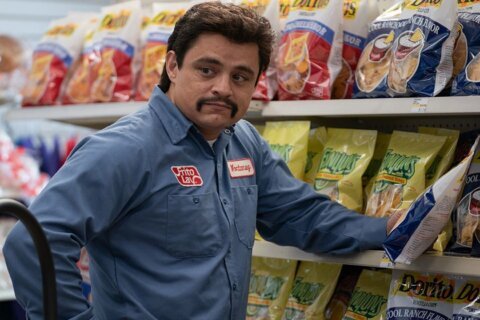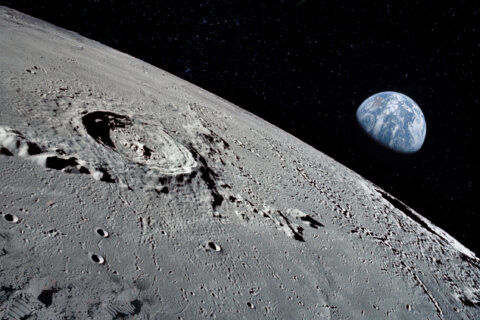Jason Fraley, WTOP film critic
WASHINGTON – Of all the movie theaters in all the towns in all the world, he walks into ours.
The National Theatre is hosting a free series of Humphrey Bogart’s best for the next two months. Screenings are Mondays at 6:30 p.m.
If you missed “Casablanca” (1942) last week, you still have time to catch plenty of Bogie gems:
July 9: “The Big Sleep” (1946)
Bogart stars as Detective Philip Marlowe in this deliciously complex film noir. The film marked his second collaboration with off-screen lover Lauren Bacall and director Howard Hawks after “To Have and Have Not” (1944). It also landed Marlowe at No. 32 on the AFI’s 50 Greatest Heroes.
July 16: “The Treasure of the Sierra Madre” (1948)
Arguably the best performance of his career, Bogart turned gold hunter Fred C. Dobbs into Premiere magazine’s No. 2 Movie Character of All Time, ahead of Scarlett O’Hara, Norman Bates and James Bond, and behind only Vito Corleone. Mel Brooks called it his favorite movie, as evidenced by his use of “We don’t need no stinkin’ badges” in “Blazing Saddles” (1974). It also holds the distinction of the first time a son (John Huston) directed his father (jig-dancing Walter Huston) to an Oscar.
July 23: “The Maltese Falcon” (1941)
The story of “The Maltese Falcon” had been made twice before. But this time, in 1941, it caught the zeitgeist, taking what the Germans were doing in the “expressionism” movement and launching “film noir” here in America. Fittingly, German star Peter Lorre (“M”) appears in a memorable supporting role, Sydney Greenstreet stars as an overweight seeker of the bird and Mary Astor plays a femme fatale. Bogart plays Detective Sam Spade in John Huston’s directorial debut.
July 30: “Key Largo” (1948)
Released the same year as “Treasure of the Sierra Madre,” John Huston pitted old gangster stars Bogart and Edward G. Robinson in a crash course with each other amidst a hurricane. The film won Claire Trevor the Oscar for Best Supporting Actress. It also paired Bogart and Bacall for a third time, inspiring the 1982 Bertie Higgins song with the nostalgic chorus, “We had it all. Just like Bogie and Bacall. Starring in our old late, late show. Sailing away to Key Largo.”
August 6: “The African Queen” (1951)
After decades of Oscar snubs, Bogart finally won the Academy Award as drunken sailor Charlie Allnut. But this was not merely a makeup Oscar. The story of Bogart’s gruff Charlie and Katharine Hepburn’s prim and proper Rose Sayer is timeless, written by Pulitzer Prize-winner James Agee, and directed once again by John Huston. A quality print of the film seemed lost to history, until a newly restored version made it look better than ever.
August 13: “Sabrina” (1954)
Aside from maybe “The Philadelphia Story” (1940), no romantic comedy has boasted such a legendary cast as “Sabrina” with Humphrey Bogart, Audrey Hepburn and William Holden. All three were fresh off recent Oscar wins: Bogart for “The African Queen” (1951), Hepburn for “Roman Holiday” (1953) and Holden for “Stalag 17.” Who better to direct than “Stalag” director Billy Wilder, who was on a role after “Double Indemnity” (1944), “The Lost Weekend” (1945), “Sunset Blvd.” (1950) and “Ace in the Hole” (1951)?
August 20: “The Caine Mutiny” (1954)
The film series wraps up with “The Caine Mutiny,” released the same year as “Sabrina.” Bogart stars as a U.S. Naval captain who grows mentally unstable. The first officer takes over and faces court-martial for mutiny. Similar to “Mutiny on the Bounty” (1935), the film co-starred Fred MacMurray, Jose Ferrer, Van Johnson and Lee Marvin. It was also a comeback for director Edward Dmytryk, one of the “Hollywood Ten” placed on the blacklist by the House Un-American Activities Committee for suspicion of communism. Bogart would be dead less than three years later.
Read more from WTOP Film Critic Jason Fraley by clicking “Fraley on Film” under the “Living” tab above, following @JasonFraleyWTOP on Twitter, and checking out his blog, The Film Spectrum.
(Copyright 2012 by WTOP. All Rights Reserved.)








